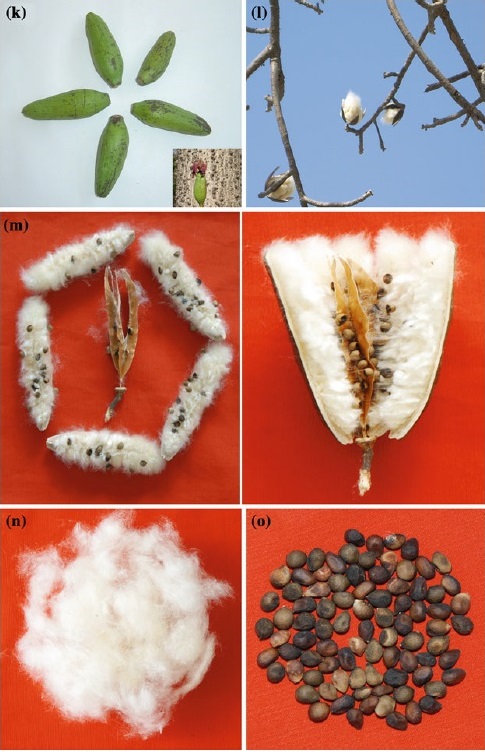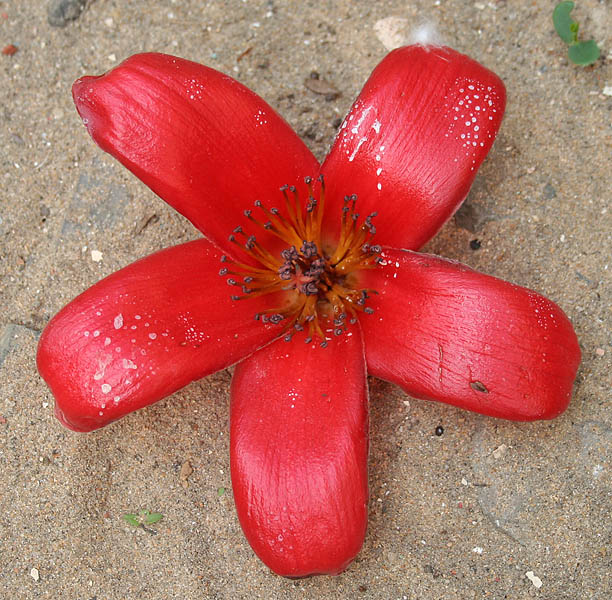
[Thread]
The cotton tree (Bombax ceiba L.), called ‘Śālmali’ in Sanskrit and ‘semal’/‘semar’ in Hindi, is well known in Sanskrit literature. One is amazed on seeing the rich set of names used for this tree in Sanskrit. The names indicate a very close observation of nature.
1/n
The cotton tree (Bombax ceiba L.), called ‘Śālmali’ in Sanskrit and ‘semal’/‘semar’ in Hindi, is well known in Sanskrit literature. One is amazed on seeing the rich set of names used for this tree in Sanskrit. The names indicate a very close observation of nature.
1/n

1) ‘kaṇṭakadruma’ (कण्टकद्रुम): “the thorny tree”. The stem of the tree has conical spines
2) ‘devavṛkṣa’ (देववृक्ष): “the tree of the gods”. As per the Mahābhārata (XII.156.7, Gita Press edition), Pitāmaha (Brahmā) rested under a Śālmali tree after creating the worlds.
2/n
2) ‘devavṛkṣa’ (देववृक्ष): “the tree of the gods”. As per the Mahābhārata (XII.156.7, Gita Press edition), Pitāmaha (Brahmā) rested under a Śālmali tree after creating the worlds.
2/n

3) ‘nirgandhapuṣpa’ (निर्गन्धपुष्प): “with scentless flowers”. The red flowers of the tree (third image) do not have a strong odour. The flower is beautiful but when it ripens, there are only cotton fibres which cannot be eaten. This led the great poet Sūradāsa to write—
3/n

3/n


“यह संसार फूल सेमर ज्यौं सुन्दर देखि लुभायौ। चाखन लाग्यौ रुई उड़ि गई हाथ कछू नहिं आयौ॥” = “This world is like the flower of a ‘semal’ tree. You were attracted by seeing the beautiful flower. When you started tasting the fruit, the cotton flew away, you did not get anything.”
4/n
4/n
4) ‘pañcaparṇī’ (पञ्चपर्णी): “five-leaved”. The tree has largely penta-foliate leaves. Even the flowers have five petals.
5/n


5/n



‘picchilā’ (पिच्छिला): “having a gum”. This is one of the several feminine names. The bark of the tree exudes a dark-brown gum known as Mocharus (‘semal-gond’) in Hindi. It is believed the gum is a result of the tree’s natural wounds caused by decay, insects, or disease.
6/n
6/n

6) ‘pūraṇī’ (पूरणी): Another feminine name which means “she who fills or completes”. I do not know why the tree is called so. Possibly because of its large size? The tree can easily grow up to 40 metres high and in some regions up to 50 or 60 metres high.
7/n
7/n
7) ‘mocā’ (मोचा): Another feminine name. Means “she who releases [gum]”. The name Mocharus for the gum most likely comes from ‘mocā’.
8) ‘yamavṛkṣa’ (यमवृक्ष): “the tree of Yama”. This name is possibly due to the long life of the tree. See comment on ‘sthirāyu’ below.
8/n
8) ‘yamavṛkṣa’ (यमवृक्ष): “the tree of Yama”. This name is possibly due to the long life of the tree. See comment on ‘sthirāyu’ below.
8/n
9) ‘raktapuṣpa’ (रक्तपुष्प): “having red flowers”.
10) ‘śālmali’ (शाल्मलि): “he who covers and holds”. The most common name for the tree in Sanskrit. Source of Hindi ‘semal’ and ‘semar’.
11) ‘śālmalī’ (शाल्मली): “she who covers and holds”. Feminine form of ‘śālmali’.
9/n

10) ‘śālmali’ (शाल्मलि): “he who covers and holds”. The most common name for the tree in Sanskrit. Source of Hindi ‘semal’ and ‘semar’.
11) ‘śālmalī’ (शाल्मली): “she who covers and holds”. Feminine form of ‘śālmali’.
9/n


12) ‘sthirāyu’ (स्थिरायु): “long-lasting, having a permanent life”. The tree was believed to live for 60,000 years: षष्टिः वर्षसहस्राणि वने जीवति शाल्मलिः.
Image: V. Jain and S.K. Verma. Pharmacology of Bombax Ceiba Linn. 2012. Heidelberg: Springer. ISBN 978-3-642-27903-4.
n/n
Image: V. Jain and S.K. Verma. Pharmacology of Bombax Ceiba Linn. 2012. Heidelberg: Springer. ISBN 978-3-642-27903-4.
n/n

• • •
Missing some Tweet in this thread? You can try to
force a refresh





